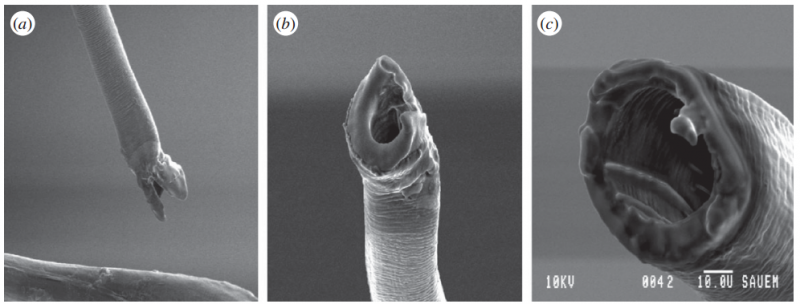May 13, 2015 report
Cutting a bugs' penis shorter found to reduce reproduction chances

(Phys.org)—A small team of researchers from the University of St Andrews and one from the University of Bristol, both in the UK has found, not surprisingly, that snipping a certain bugs' penis caused it to have less success in producing offspring. In their paper published in Proceedings of the Royal Society B, Liam Dougherty, Imran Rahman, Emily Burdfield-Steel, E. V. Greenway and David Shuker describe their experiments with Lygaeus simulans bugs and what they learned through their efforts.
Lopping off sections of a penis, for most species would involve serious injury and trauma (for some the mere thought of it might be enough)—but not so, apparently, for L. simulans. The males of these little bugs, which are typically just 11 millimeters or so in length, come equipped with a penis that is very nearly comical in its length, on average 7 mm, which for those keeping track, is in the neighborhood of two thirds of its body length (it drags the thing around beneath itself). Even more odd is that most of the penis, aka its intromittent organ, is bereft of nerves, muscles or even blood vessels. And even odder than that is the fact that the female organ into which the male places its appendage is much too short to accommodate such length. Thus, the researchers sought out to discover the reason for such a mismatch.
To find out if the male could survive and mate if its penis was cut shorter, the team took scissors in hand and set to work snipping off differing lengths from a host of "volunteers." They then watched to see how well the bugs copulated and then measured their reproductive success. As it turned out, the shortened organs did not appear to cause undue hardship to the male, or the females for that matter. The bugs copulated as normal—it was only when counting offspring that a change was noted. The more they cut off, the less reproductively successful the males were. Cutting off 5 percent of the penis, for example, resulted in a big drop-off, and cutting off thirty percent cut both the rate of copulation and the rate of insemination.
The team also took micro-CT scans of the bugs in mid-copulation and discovered that in order for the male organ to fit inside the female parts, a lot of coiling occurred. With bits cut off, there was less to coil, and that, the team surmises, is likely the answer to why the males have such a long organ.
More information: Experimental reduction of intromittent organ length reduces male reproductive success in a bug, Proceedings of the Royal Society B, Published 13 May 2015, DOI: 10.1098/rspb.2015.0724
Abstract
It is now clear in many species that male and female genital evolution has been shaped by sexual selection. However, it has historically been difficult to confirm correlations between morphology and fitness, as genital traits are complex and manipulation tends to impair function significantly. In this study, we investigate the functional morphology of the elongate male intromittent organ (or processus) of the seed bug Lygaeus simulans, in two ways. We first use micro-computed tomography (micro-CT) and flash-freezing to reconstruct in high resolution the interaction between the male intromittent organ and the female internal reproductive anatomy during mating. We successfully trace the path of the male processus inside the female reproductive tract. We then confirm that male processus length influences sperm transfer by experimental ablation and show that males with shortened processi have significantly reduced post-copulatory reproductive success. Importantly, male insemination function is not affected by this manipulation per se. We thus present rare, direct experimental evidence that an internal genital trait functions to increase reproductive success and show that, with appropriate staining, micro-CT is an excellent tool for investigating the functional morphology of insect genitalia during copulation.
Journal information: Proceedings of the Royal Society B
© 2015 Phys.org



















